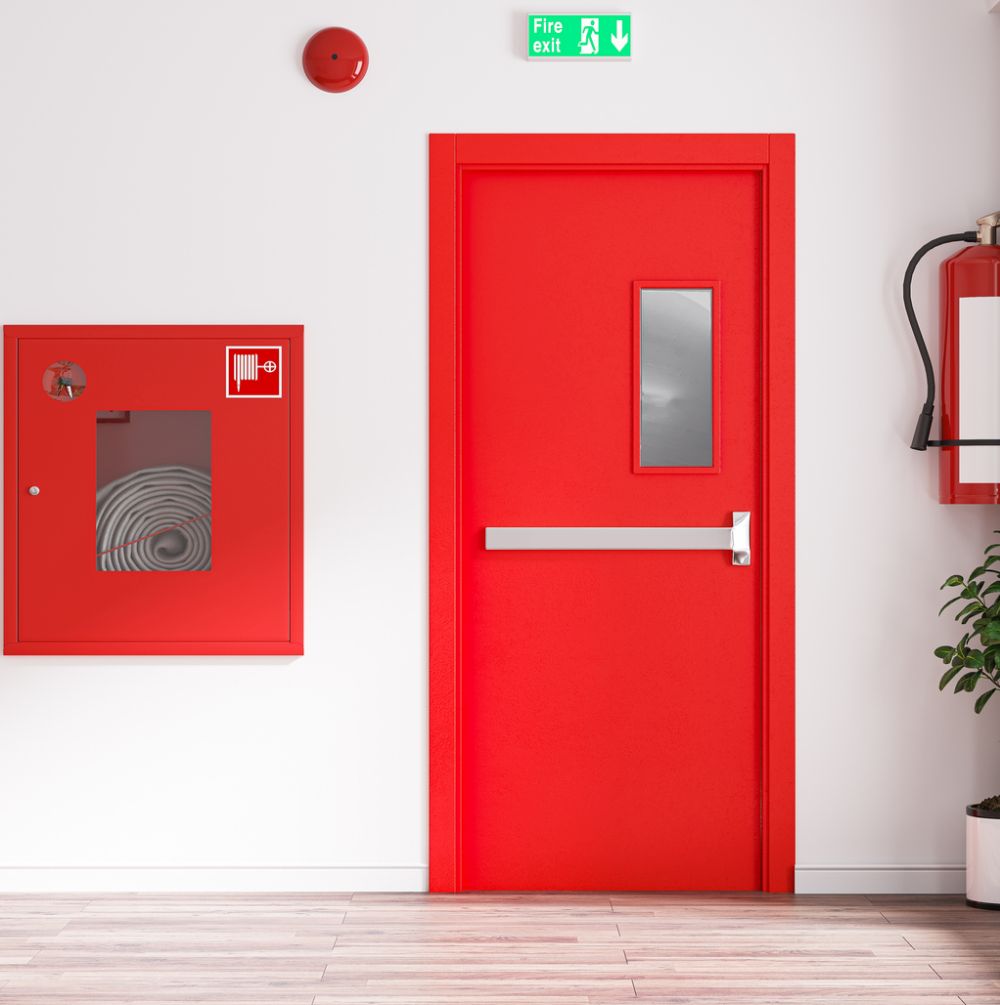In the world of fire safety, every second counts. Fire doors are a critical line of defence, slowing the spread of flames and smoke, protecting escape routes, and ultimately saving lives. Whether in commercial, residential, or industrial settings, these specialised doors are designed to withstand extreme conditions, providing vital time for occupants to evacuate safely.
About Fire Doors
Typically constructed from materials like steel or other fire-resistant substances, fire doors are equipped with intumescent seals that expand when exposed to heat, sealing gaps around the door frame. This feature helps to keep flames and smoke contained within a designated area.
For a fire door to be certified it must have:
- Fire rated frame and hardware
- Fire rated automatic door closer
- It needs to be able to withstand the heat exposure caused by a fire for 60 or 120 minutes, according to the Australian Standards AS1905 (fire resistant door sets).
In Australia, fire doors are assigned an FRL rating dependant on the length of time they can withstand fire for and how long they will remain cool to the touch for. A -60/30 door offers 30 minutes of protection from fire and will remain cool for 30. The dash (-) means that the door is non load bearing, instead providing insulation protection from fire.
Fire doors are tested and rated based on:
Structural adequacy – how long the structure will support the load and remain vertical.
Integrity – how long the structure will inhibit flames.
Insulation – how long the structure will not increase in temperature.
In Australia, fire doors and components can only be tested and certified by registered, accredited testing authorities. The National Association of Testing Authorities governs testing regulations and organisations in Australia.
The Benefits
One of the main benefits of fire doors is their ability to contain flames, allowing occupants more time to evacuate and reducing the risk of injury. These doors are designed to withstand high temperatures for a specified period, typically ranging from 30 minutes to several hours, depending on their rating.
Another significant advantage is that fire doors help compartmentalise a building, preventing fire from spreading from one area to another. This containment not only protects lives but also minimises property damage and disruption during emergencies. Most fire doors are equipped with self-closing mechanisms that ensure they remain shut when not in use, further enhancing their effectiveness.
Unlike active fire protection systems such as sprinklers and alarms, fire doors work as part of a building’s passive fire protection strategy. They function continuously without the need for activation, providing an essential layer of defence in emergencies.
Importantly, fire doors contribute to overall compliance with safety regulations and building codes. Installing certified fire doors can help meet legal requirements while demonstrating a commitment to safety for employees and visitors alike.
Maintenance and Inspection – Ensuring Effectiveness
To ensure their effectiveness, regular maintenance and inspection are essential.
It is important to conduct visual checks of fire doors at least once a month. This includes checking for any visible damage such as dents or cracks in the door itself, as well as ensuring that all hardware components, such as hinges, locks, and closers, are functioning properly. Any signs of wear or malfunction should be addressed immediately to maintain the integrity of the door.
In addition to monthly checks, inspections by certified professionals are required. In Australia, fire doors must be maintained in accordance with the Building Code of Australia and local council legislation. Fire doors should be inspected and maintained by a qualified person at the below intervals:
Common Property Fire Doors – 6 months
Sole Occupancy Unit Fire Doors – 12 months.
It’s important to stay up to date with your local council’s requirements, as the rules may vary depending on the type of building.
The Future of Fire Door Technology
As regulations evolve and the demand for safer buildings increases, innovations in materials, design, and functionality are emerging.
One key area of development is the use of advanced materials that offer better fire resistance while being lighter and more durable. For instance, new composite materials are being engineered to withstand higher temperatures and provide longer-lasting protection compared to traditional steel or timber doors.
Additionally, smart technology integration is becoming a prominent feature in fire door systems. These innovations include sensors that can detect smoke or heat, automatically closing doors to contain fires more effectively. Advancements in connectivity will allow for real-time monitoring of fire door status via building management systems, ensuring compliance with safety standards.
Another exciting trend is the focus on aesthetics without compromising safety. Manufacturers are designing fire doors that blend seamlessly with architectural elements while still meeting stringent safety regulations. This approach not only enhances the visual appeal of a building but also encourages adherence to fire safety measures.
Fire Doors Safeguard Lives and Property
Investing in quality fire doors is an important investment in safety – one that protects both individuals and property from the devastating effects of fires. Fire extinguishers, fire blankets, hose reels, and fire doors all play an active role in fire safety.
For fire safety equipment such as extinguishers, reach out to Safety Dave today. We are Australia’s safety experts, we can help with everything you need to keep your home, workplace, car, or building safe – reversing cameras, TPMS, AED defibrillator – shop our range online now or call 1800 072 388 to discuss your safety needs with our expert staff.


